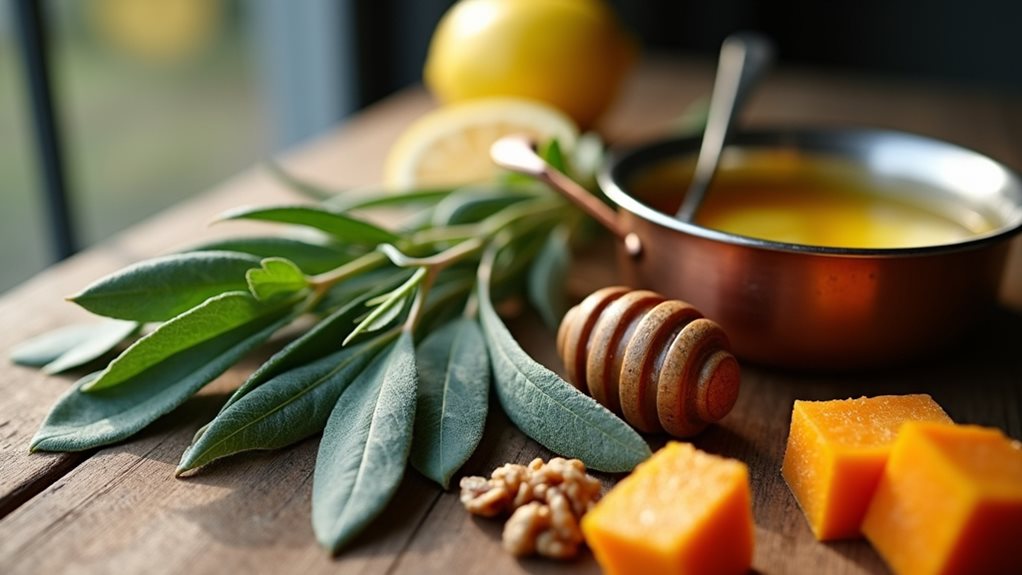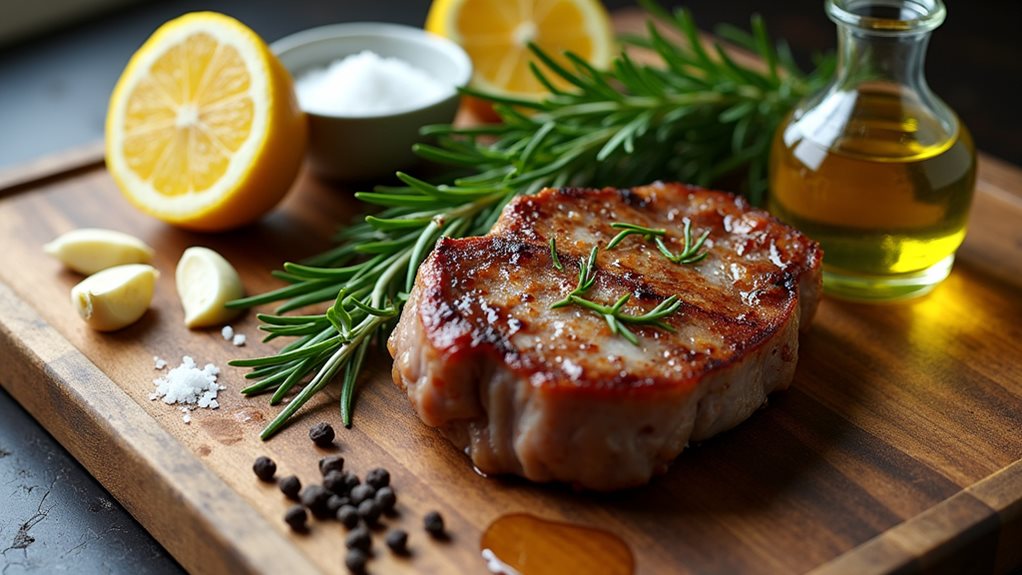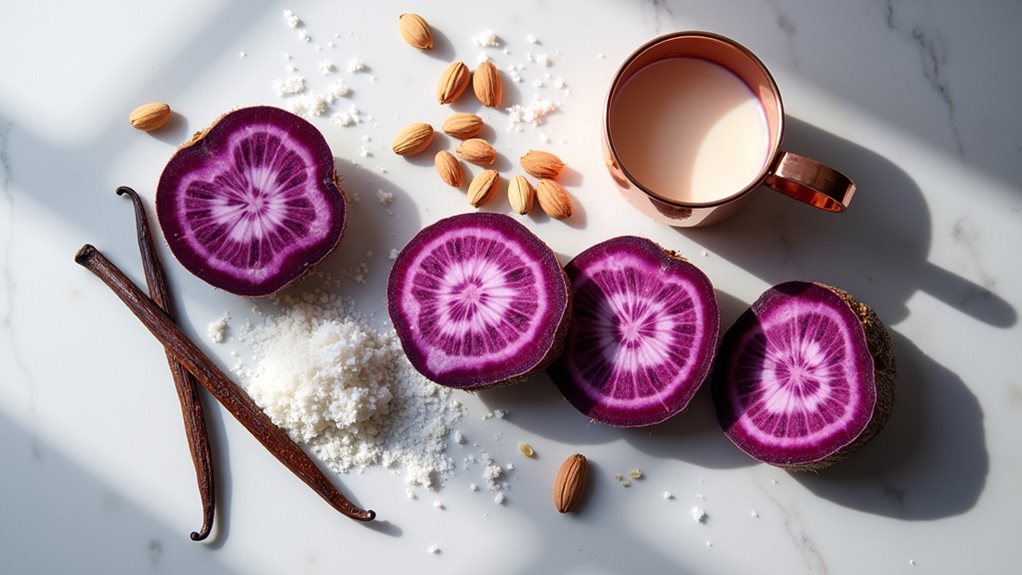Sage pairs beautifully with proteins like lamb, chicken, and pork, while also complementing vegetables such as squash, potatoes, and mushrooms. You'll find it works wonderfully with other Mediterranean herbs like rosemary and thyme, and adds complexity to fatty foods through brown butter sauces. Don't limit this versatile herb to savory applications—try it with fruits, honey, or caramel for unexpected sweet combinations. The herb's distinctive earthy profile offers countless culinary possibilities to explore.
The Fragrant History of Sage in Global Cuisine

One can't fully appreciate sage's versatility without understanding its rich historical journey through global cuisines. This herb's Mediterranean origins trace back to ancient Greeks and Romans, who valued it not just for flavor but for its healing properties. Sage symbolism is deeply rooted in its Latin name "salvare" meaning "to be saved," reflecting its esteemed medicinal status. Thomas Jefferson, known for his agricultural pursuits, was among early American cultivators who grew sage at Monticello since at least 1794. Its distinctive grey-green leaves are what give rise to the commonly known "sage color" in modern terminology. You'll find sage woven through historical rituals and monastery gardens of the Middle Ages, where it was cultivated for both spiritual and practical purposes.
Classic Sage and Protein Combinations
When exploring sage's culinary versatility, you'll find its earthy, aromatic profile creates magical harmony with various proteins, transforming ordinary dishes into memorable meals.
Classic sage meat pairings showcase the herb's ability to enhance flavors across cuisines—try it with lamb in hearty stews, beef roasts, or chicken dishes where it complements garlic beautifully.
Don't limit yourself to animal proteins; plant-based sage applications are equally impressive.
This versatile herb elevates tofu when included in marinades, adds complexity to lentil soups, and brings depth to chickpea dishes like hummus.
You'll appreciate how sage complements seitan in vegetarian stews or infuses tempeh with rich, herbal notes.
For complete protein combinations, incorporate sage into quinoa salads or pair it with seeds like pumpkin or sunflower for nutritional powerhouses. Try combining sage with browned butter to create a subtly peppery flavor that perfectly enhances the nutty qualities of many protein dishes. Soy products like edamame and tempeh work wonderfully with sage, providing all essential aminoacids while complementing the herb's savory profile. Using an oil mister technique allows you to add just a touch of sage-infused oil to your protein dishes for maximum flavor with minimal calories.
Unexpected Fruit Pairings That Elevate Sage
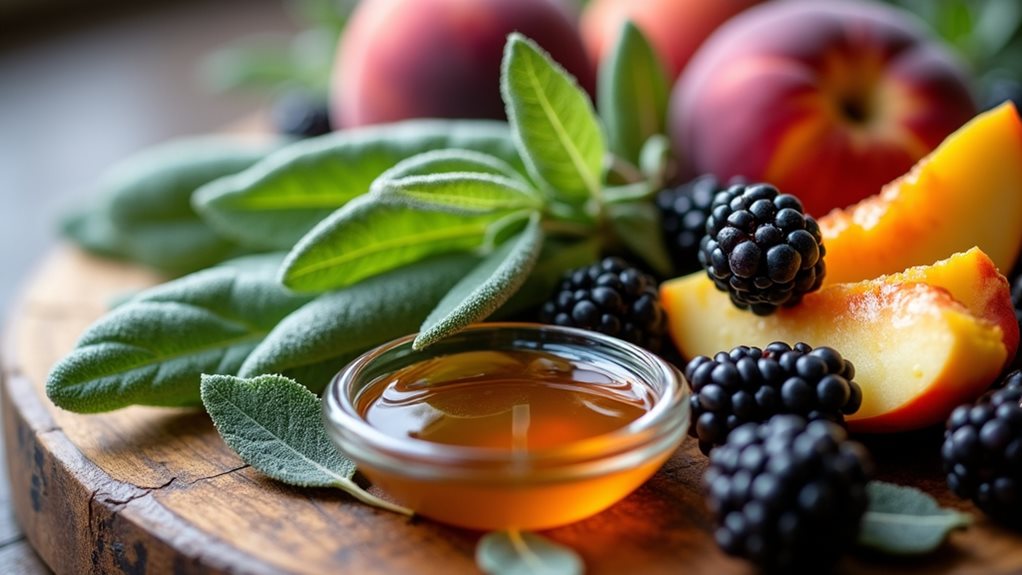
Though sage traditionally pairs with savory dishes, its aromatic profile works surprisingly well with certain fruits, particularly berries like strawberries and blueberries that balance sage's earthiness with natural sweetness.
You'll find that citrus fruits, especially orange and lemon, create bright, invigorating contrasts when combined with sage in desserts such as sorbets, tarts, or infused custards. Surprising combinations like pomegranate and cucumber can also complement sage's herbaceous notes, adding depth and complexity to cocktails and beverages. White beans and sage create a classic foundation that can be elevated with baked pears for a seasonal fall dish with perfect flavor harmony. For a comforting autumn meal, try incorporating sage into butternut squash risotto where its earthy flavor enhances the natural sweetness of the roasted squash.
These unexpected pairings open new culinary possibilities, allowing you to experiment with sage beyond its conventional applications while adding complexity to fruit-forward dishes.
Sage and Berries
While many herb enthusiasts might gravitate toward traditional pairings, sage's distinctive earthy flavor creates surprisingly successful combinations with certain berries, though not all fruit matches yield equal results.
You'll find sage and blackberries form an excellent partnership in jams, where sage adds complexity without overwhelming the berry's sweetness. However, avoid using sage in blackberry pies where its aroma can dominate.
When considering sage and raspberries, proceed with caution—this combination isn't typical, as raspberries generally prefer softer herbs like mint or thyme. These preferences align with insights from flavor pairing charts that show certain herbs harmonize better with specific fruits.
Blueberries offer the most versatile pairing potential with sage, especially when the herb is finely chopped for jam preparation. As with performance evaluation in alpaca_eval, results can vary widely depending on specific combinations and techniques.
For strawberries, it's best to steer clear of sage entirely, as its woody character clashes with their bright profile.
Citrus-Sage Desserts
The bright, zesty flavors of citrus fruits create unexpectedly harmonious pairings with sage's earthy profile, offering a sophisticated alternative to traditional sweet desserts. When working with this combination, you'll find Meyer lemons provide a sweeter foundation than standard varieties, allowing you to explore different citrus variations that complement sage's herbaceous notes.
For ideal dessert textures, incorporate olive oil and yogurt into your batters—these ingredients maintain moisture while enhancing sage's subtle complexity. Many bakers recommend reducing sage amounts for a better balance of flavors, especially when pairing with bright citrus notes. This approach creates a delightfully moist texture similar to the traditional French Yogurt Cake that has inspired many tea-time favorites.
Try whisking finely chopped sage leaves with lemon zest to release essential oils before folding into your mixture. Bake at 325-350°F for delicate cakes that showcase this flavor pairing.
The Mediterranean-inspired combination works year-round, whether you're creating light summer confections or hearty winter cakes with a citrus-sage glaze that balances sweet and savory profiles.
Sage in Vegetable Dishes: Beyond the Basics
Sage brings a transformative quality to vegetable dishes, elevating ordinary ingredients with its distinctive earthy, piney aroma. You'll find it excels in roasted salads featuring sweet potatoes and beets, where its earthy notes balance natural sweetness.
Try creating sage marinades with olive oil, garlic, and lemon juice to coat vegetables before grilling—the result offers complex flavor layers with minimal effort.
For stuffed vegetables, sage shines as a key flavor component. Mix chopped sage into quinoa fillings for bell peppers or incorporate it into zucchini boats for a savory dimension.
Beyond these applications, consider experimenting with sage in potato rösti or sprinkled over grilled portobello mushrooms. The herb's versatility makes it perfect for both traditional recipes and innovative vegetable preparations.
Similar to flaky crust applications in chicken pot pie, sage can be incorporated into homemade pastry dough for savory vegetable tarts and galettes.
Herb and Spice Companions for Sage-Forward Recipes
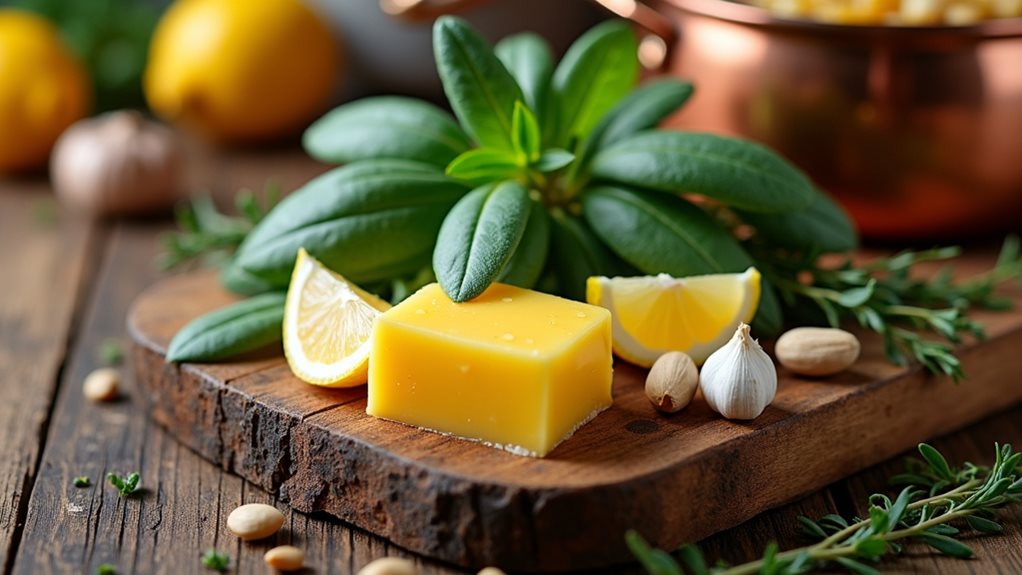
Creating exceptional sage-forward recipes depends largely on understanding which herbs and spices complement its distinctive earthy profile.
For classic Mediterranean combinations, pair sage with rosemary and thyme in your herbal infusions, creating depth without overpowering the primary sage notes. You'll find marjoram adds a sweet undertone that balances sage's intensity in roasts and stews.
For more adventurous sage seasoning blends, incorporate warming spices like cumin or nutmeg. These create complex layers of flavor that elevate simple dishes to memorable status.
Garlic remains sage's steadfast companion, though use it judiciously to prevent dominating the herb's subtle qualities. For brightness, introduce citrus elements—lemon zest cuts through sage's earthiness while preserving its aromatic integrity.
This balanced approach guarantees your sage-forward dishes maintain sophisticated flavor profiles. When preparing sage in sautéed dishes, maintain proper heat control to release its aromatic oils without burning this delicate herb.
Sage in Sweet Applications: Desserts and Confections
You'll discover that sage can transform ordinary ice cream into a sophisticated treat when infused into cream before churning, creating flavors that pair exceptionally well with honey or caramel ribbons.
For a simpler sweet application, try making fruit sage compotes by gently simmering your favorite seasonal fruits with sugar, lemon juice, and fresh sage leaves until the mixture thickens and the flavors meld.
These versatile sage-infused creations can elevate everyday desserts like vanilla ice cream, pound cake, or yogurt into memorable culinary experiences that showcase sage's unexpected affinity for sweet applications.
Sage-Infused Ice Creams
Among the most sophisticated dessert applications for this versatile herb, sage-infused ice creams offer a remarkable journey into unexpected flavor territory.
You'll find the herbaceous depth of sage perfectly complements creamy textures, especially when using a French-style custard base with egg yolks.
For the best herbal infusion, steep sage leaves in warm cream before straining them out.
Try pairing sage with brown butter for rich nuttiness, or with orange for a bright contrast to the herb's earthiness.
Don't limit yourself to just the ice cream base—crispy fried sage leaves make an exceptional textural garnish.
When creating your sage ice cream, remember that balancing sweetness with a pinch of salt will enhance the complex flavors and prevent the dessert from becoming cloying.
Fruit Sage Compotes
While sage is often relegated to savory dishes, this versatile herb shines brilliantly in fruit compotes where its earthy, aromatic qualities transform ordinary sweet preparations into complex culinary experiences.
You'll find rhubarb works exceptionally well with sage, creating a tart-herbal harmony that's perfect for spring desserts. For deeper flavors, try blackberry sage compote with a splash of balsamic vinegar, which enhances both fruit texture and depth.
When preparing these compote variations, simmer your fruits gently—stone fruits and berries respond particularly well to this treatment.
Stir frequently and reduce the liquid to your desired consistency. Don't forget to balance flavors with sweeteners like honey or maple syrup, and a touch of acid (lemon or vinegar) to brighten the mixture.
Serve your creation over ice cream or as filling for pastries.
Crafting the Perfect Sage-Infused Butter and Oils
The transformation of ordinary butter into a sage-infused delicacy begins with selecting the right ingredients and mastering a few essential techniques. Unsalted butter provides the ideal canvas for herb infusion techniques, while a light-colored pan helps you monitor the browning process without burning those precious milk solids.
Unsalted butter whispers possibility, awaiting transformation through careful heat and patient technique into something transcendent.
For the most vibrant results, swirl your butter over medium heat until it develops a nutty aroma, then add fresh sage leaves and remove from heat. The residual warmth will extract the herb's earthy essence.
After cooling slightly, consider whisking for a lighter texture—one of many flavor balancing tips that elevates your creation. Don't forget that acidity from lemon zest can brighten the profile, while sea salt enhances without overwhelming.
Consider gently bruising the sage leaves before adding them to release more of their essential oils and intensify the aromatic compounds in your infusion.
Store your finished butter in an airtight container for up to two weeks.
Seasonal Cooking With Fresh vs. Dried Sage
Seasons dramatically influence how you'll use sage in your kitchen, with each time of year offering unique opportunities to showcase this versatile herb.
In winter, dried sage's concentrated flavor enhances hearty stews and stuffings, while summer calls for fresh sage's milder profile in grilled dishes and salads.
Fresh sage benefits include:
- Higher potency of active compounds for superior health benefits
- Milder flavor that won't overpower delicate summer produce
- Excellent texture for crispy garnishes on pasta and gnocchi
For ideal dried sage storage, keep it in airtight containers away from light and moisture.
It'll last up to a year while retaining its robust character—perfect for fall's roasted squash dishes when you're craving that earthy, slightly bitter warmth that defines comfort cooking.
Frequently Asked Questions
Can Sage Be Toxic When Consumed in Large Quantities?
Yes, you'll face sage toxicity levels if consuming it excessively. Sage consumption guidelines recommend limited use as it contains thujone, which can trigger seizures, hypertension, and gastrointestinal issues in large quantities.
How Do Sage Varieties Differ in Flavor Profiles?
When exploring the garden of herbal treasures, you'll discover sage varieties offer distinct flavor nuances. Common sage delivers warm-spicy notes, Berggarten packs a pungent punch, Golden sage provides mild subtlety, while Greek sage offers sweet resinous character.
What Are the Best Non-Alcoholic Beverages to Pair With Sage?
You'll love sage tea with cranberry or grapefruit for a revitalizing twist. Try herbal infusions with ginger and turmeric for warmth, or create innovative mocktails using sage simple syrup and sparkling water.
Can You Freeze Fresh Sage Without Losing Flavor?
Yes, you can freeze fresh sage without sacrificing flavor! Guarantee proper fresh sage preservation by thoroughly drying leaves before storing in airtight containers. Your frozen herb storage will maintain essence for up to a year when properly sealed.
How Does Sage Complement Different Cooking Oils?
Sage transforms oils into flavor superweapons! You'll find it revolutionizes olive oil, creating a versatile sage oil that elevates everything from marinades to dressings. It's particularly magnificent with extra virgin varieties for innovative culinary creations.
Final Thoughts
As you explore sage's versatile charm, remember that this aromatic herb—like a chameleon of the culinary world—transforms with each pairing you try. Whether you're browning butter with sage for pasta, infusing oils for drizzling over vegetables, or creating sweet-savory desserts, you'll find endless possibilities. Trust your palate, experiment with seasonal ingredients, and you'll soon discover that sage isn't just an herb—it's a gateway to more sophisticated, nuanced cooking.

